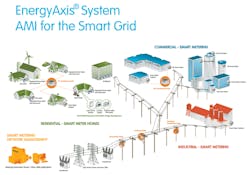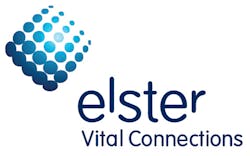The AMI Communications Network: Where it’s headed and how to get there from here
For many years now, forward-thinking utilities around the world have invested in technology solutions to help run their operations more efficiently. In fact, as far back as the mid-80s, companies began deploying Automated Meter Reading (AMR) systems to obtain data that is difficult to access, reduce costs and enable more accurate and timely billing. Though a major step forward in the realm of meter reading, AMR systems all had one important shortcoming: they offered no ability to communicate from the utility to the meter. This one-way-only communication significantly limited AMR capability.
The evolution in communications technology added two-way communications networks, today’s hallmark of Advanced Metering Infrastructure, or AMI. In fact, we would submit that it is not the fixed network, but rather two-way communications that are important. Walk-by, drive-by or even fly-by data collection—as long as it is capable of robust two-way messaging – can be incorporated into the evolving network of networks that is AMI.
AMI: Two-Way Communication for More Ways to Enhance Operations
Today’s AMI solution is a sophisticated array of electronic/digital hardware and software that combines interval data measurement with continuously available remote communications to enable two-way messaging for command and control as well as the exchange of data – both from the meter to the utility and from the utility to the meter.
The result? With AMI, utilities can move from merely reading meters automatically to actually managing and controlling key aspects of the grid. And with modern analytics and predictive science, a whole new world awaits when it comes to automating, predicting, monitoring and controlling the grid, enabling self-healing capabilities and creating entirely new relationships between utilities and their customers. This also opens up new opportunities for AMI and Distribution Automation (DA) convergence via the ability to monitor and control DA grid devices through the AMI communication networks.
As the Smart Grid Advances, so do Network Communications Requirements
Another consideration is the availability of low-cost cellular service for point-to-point, cellular-connected smart meters. Utilizing high-speed, IP-based cellular networks presents numerous opportunities for the utility to take advantage of new applications for smart electric metering that require real-time, high-speed networks (i.e., prepay, outage management and voltage conservation monitoring).
The Promise of AMI: Smarter Technology for the Smart Grid
What exactly should you expect from an AMI solution?
- Greater Robustness: The NAN mesh communication networks should be capable of reliable self building and self healing. The networks should also support the ability to migrate to new standards as they become available. For example, migrating to a full scale, IP-based protocol platform that supports all applications would lower costs, minimize training and maintenance, and offer a future-proof communication solution.
- Improved Versatility: Utilities should not be limited to one form of communication protocol when constructing their networks. They should be empowered to use a mix of technologies with communication networks able to accept data transmitted across any media. A versatile AMI system will be able to support many communication technologies concurrently, using a hybrid solution of cellular meters, mesh network meters and even two-way walk-by/drive-by communication systems.
- Better Security: Some current AMI systems, lacking a standard communication protocol, have incorporated post- production security mechanisms. In a truly secure IP network, a standardized security system (for example, ANSI C12.22 with its standardized encryption algorithm) is incorporated into the endpoints, communication mechanisms and head end, thus ensuring a standardized robust and secure AMI solution.
- Enhanced Flexibility: Technology is constantly advancing, and today’s components can quickly become obsolete. Time and money are lost removing, discarding and replacing old meters with new endpoints whenever metering vendors update their systems. AMI solutions should incorporate endpoints that are capable of remotely upgrading communications protocol.
- Distributed Intelligence and Storage: Future technology improvements will also likely grant FANs/WANs the ability to make more decisions on the spot as well as store vast amounts of data. This will enable NANs to support the control and management of microgrids, which will greatly improve the reliability and efficiency of the grid as a whole.
A Brighter Future for Utilities and Your Customers
So what is the AMI communication system of tomorrow? Simply put, it isn’t just for AMI. The future of grid communications goes far beyond just meters or just distribution automation or just communications support for today’s intelligent end devices. Soon an integrated, robust, highly reliable network will support ALL these devices and applications and very likely some we haven’t even thought of yet.
The future is a ubiquitous, scalable system of communication that supports AMI, DA and SCADA. It will utilize many different types of technologies for data transmission including mesh, point-to-point, wired and wireless, with the decision on which to select determined by the best available option for each node. It will be IP-based, allowing addressing to individual devices and peer-to-peer communications. It will be highly adaptive and flexible, allowing for additional devices to be easily added to the existing network. It will be robust and secure, adhering to all environmental requirements and utilizing open standards to ensure seamless integration.
Most importantly, the next-generation grid communication network has a well-thought-out migration path that will accommodate and support legacy equipment in the field. This means that as newer technology becomes available, older protocols will still be supported and will share the same network infrastructure and be secured using state-of-the-art technologies.
The next-generation grid communication network will be managed by a single head end platform with access to both network management functions as well as analytical tools. This head end application will be easy to use and will be secure, scalable and flexible—allowing future tools and capabilities to be added simply and easily. The future is a vastly improved network management user experience.
So what does this mean for endpoint devices? In order to support the next generation of grid networks, the meters installed tomorrow must be smarter, flexible, robust and secure from a communications perspective. These devices must be able to adapt to whatever technology choices have been made with regards to transport, protocols and management. These devices must be able to perform basic analysis and support new functionalities without requiring an interaction with the control center. As always, they must be highly accurate and robust because customers depend on them.
Through a smart grid built on advanced communications network technologies, next-generation AMI solutions with “smarter” smart meters will be able to leverage these technologies, becoming more intelligent, more secure, more resilient, more versatile and more efficient. Consequently, the next-generation AMI solutions will enable utilities to:
- Instantly sense outages and trigger corrective action
- Automatically route and manage power to respond to changing conditions
- Employ in-home devices to apprise customers of their utility usage patterns, then shift loads to reduce overall and peak demands
- Bill individual customers according to their unique usage patterns
- Tackle many and various future applications for the data being collected
In short, the technology advancements made possible through grid and AMI advanced communications networks will empower your utility – and your customers – like never before.
Acronym Soup:WAN, NAN, FAN, LAN, HAN, PAN
Brief definitions for the curious.
The evolution from AMR to AMI was made possible by advanced communications networks, including software and hardware components. The smart grid is architecturally similar to the Internet, in that it is hierarchical and has clear points of demarcation.
-
WAN or FAN: The wide area network (WAN) or field area network (FAN) are often referred to as the backhaul. These networks provide communications from the utility head end out to devices in the field. Field access or collection points on the edge of the WAN provide connections to and/or consolidation of meter data collected by the NAN for retrieval. The WAN is also used to communicate with all or specific devices in the field to initiate tasks, upgrade firmware or request specific data.
The FAN/WAN transmits large amounts of data from the NAN to the utility head end application. The WAN is also used for individual direct connect meters. For this reason, the FAN/WAN in a robust IP network should be able support many different communication technologies such as public cellular service, private radio networks or Ethernet
based (fiber or co-ax). - NAN or LAN: The neighborhood area network (NAN) (sometimes called the local area network [LAN]) may be a radio frequency (RF) mesh, or power line carrier (PLC) network. The NAN provides sub-networks of meters, typically extending the reach to the majority of the meter population—especially residential meters.
- Han or Pan: The home area network (HAN), premise area network (PAN) or business/industrial area network, provide interfaces into the home and business for energy consumption monitoring and to support demand response functionality. The HAN includes the communication network from the meter to devices inside the consumer’s home (or commercial building). Most HAN traffic occurs between the meter and the in-home display (IHD) and/or load control devices. Like the NAN, HAN communications can also be transmitted via PLC or RF technologies.
As the Smart Grid Advances, so do Network Communications Requirements
In the last few years there has been a steady progression in communications requirements for utility field automation applications as the applications themselves have become more advanced. One-way and narrowband proprietary communications networks that were the choice of many utilities a few years ago have given way to more advanced high bandwidth, two-way communications supporting real-time situational awareness and control of the distribution substation and feeders. Many utilities are in the process of specifying and implementing the next stage in that evolution that incorporates capabilities such as distribution automation, substation automation and video security.
Many utilities initiated deployment of their smart grid with AMI. However, AMI is just one of many applications required to fulfill the smart grid vision. Distribution automation and control, outage management, demand response and mobile workforce applications will work together to help utilities more efficiently leverage assets in the field and make the vision a reality. Deploying and managing separate networks for each application is not cost-effective. A single, standards-based, high-performance network that aggregates communications for multiple applications and subnets is simpler to manage and creates a better ROI. Over the next three to five years, additional applications for smart grids related to distribution automation, distributed generation, electric vehicle integration and substation video security will indeed require the enhanced functionality expected in the next-generation grid communication network."
- Adam Guglielmo, Director, Business Development, ABB Tropos Wireless Communication Systems
Wireless communications have come a long way over the last 10 years.
Today’s wireless technology provides meaningful improvements in network performance. Bandwidth, latency, reach and reliability have all improved. Elster’s wireless technology is a great example. Elster has deployed over 120 wireless networks at public utilities, cooperative utilities and investor owned utilities. Elster’s 3rd generation RF Mesh is capable of 1 mile hops and can extend to 16 hops without the use of separate collectors or repeaters. Today these higher performing, wireless networks are as suitable for many rural applications as they are for urban applications."
- Glenn English, CEO of the National Rural Electric Cooperative Association (NRECA)
About the Authors
Chris Germano, Director of Strategic Alliances, Elster Solutions
Chris Germano is responsible for Elster’s partnering and alliances. His previous role with Elster was as senior product manager of WAN solutions. Chris now manages partner relationships, including those strategic partners that provide Elster products and solutions for WAN communications. He works closely with Elster Product Management teams worldwide to provide the best-in-class partner solutions in all areas of AMI and smart grid, allowing Elster to provide a comprehensive AMI solution.
Chris has extensive hardware and software product management and partner management experience, including large-scale telecommunications systems, intelligent connectivity management solutions as well as working with software and hardware vendors on strategic partnerships. He has worked for TE Connectivity, IBM, Nortel and Siemens. He earned a BSEE from the University of Central Florida.
Christine Cole, Sr. Product Manager, Communications, Elster Solutions
As senior product manager, Christine Cole is responsible for Elster’s communications strategy for AMI, DA and smart cities solutions. Christine creates and manages product line roadmap to ensure strategic fit with corporate portfolio. She works closely with strategic partners and Elster teams worldwide to create and drive best-in-class communications solutions for the global market.
Christine has extensive strategic product management experience, including large-scale telecommunications systems, mission critical communications for utilities, and control and monitoring systems for utilities and municipalities. She earned her utility experience as a global product manager for substation communications at Schweitzer Engineering Laboratories, and street and area lighting control and monitoring systems at TE Connectivity, Energy Division. She earned a BSEE from the University of Louisiana and began her career as a flight software engineer on the NASA Space Shuttle program at Johnson Space Center in Houston.
About Elster Solutions
From smart meters and other grid sensors, to advanced metering infrastructure (AMI), meter data management (MDM), network communications, data analytics and pre-integrated, partner-based solutions for sophisticated grid power management, Elster’s solutions unlock the data stored in electric, gas and water meters. By transforming meter data into meaningful grid performance information, Elster helps utilities and their customers improve system reliability, enhance operational efficiency, enhance customer service and reduce their carbon footprint.
Content brought to you by: Elster






